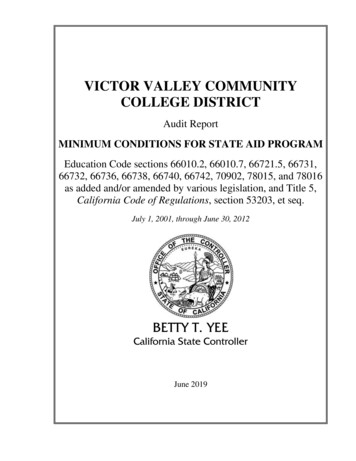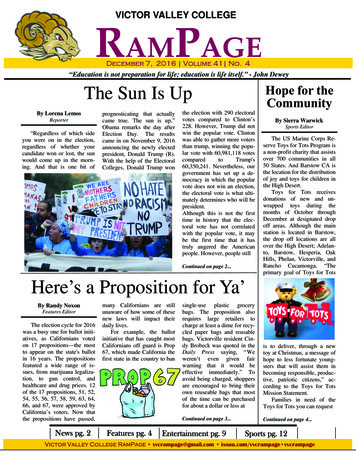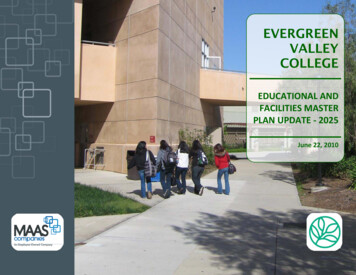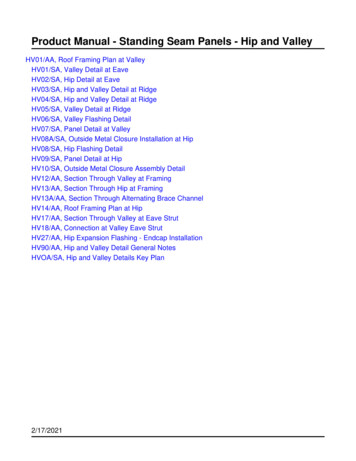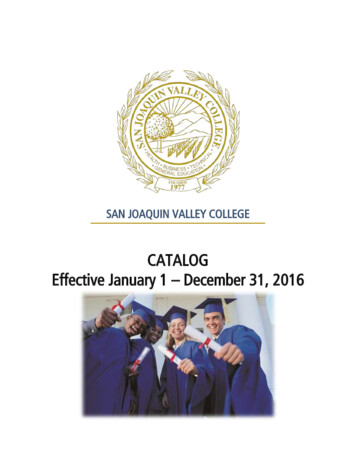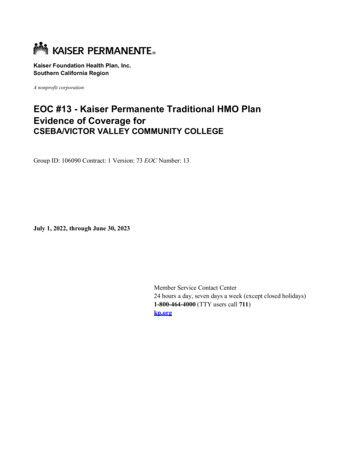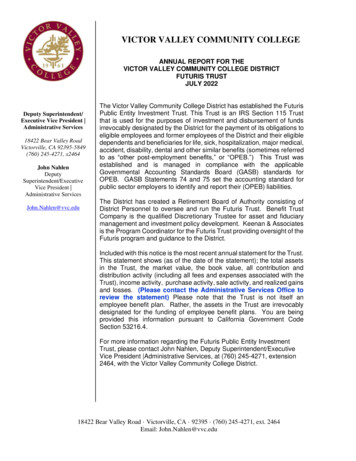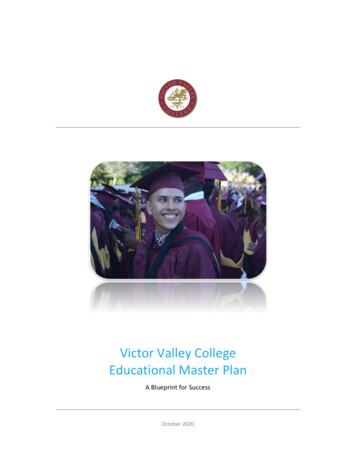
Transcription
Victor Valley CollegeEducational Master PlanA Blueprint for SuccessOctober 2020
Victor Valley CollegeEducational Master Plan 2ForwardThe Victor Valley College Educational Mater Plan: A Blueprint for Succes is a five-year road map to position the college as apreeminent provider of postsecondary education in the High Desert region, San Bernardino County, state of California, andnation. An extensive planning process, involving numerous college stakeholders in every Victor Valley College (VVC)department, was undertaken to develop this plan. The process began in 2019 with the completion of a comprehensiveEnvironmental Scan and meetings conducted with every academic department. These activities culminated with thedevelopment of initial goals. At the beginning of 2020, additional environmental scanning was conducted on the future ofhigher education and future trends in each industry pertaining to programs offered at VVC. Subsequetly, meetings wereconducted with each academic department to consider these future findings and program goals were adjusted, ifnecessary. Themes that emerged from all planning efforts to that point, along with major priorities and endeavors currentlyunderway at VVC, were synthesized into a strategic framework that provides the glue for this educational master plan. Ateam was established to consider and develop plans for increasing excellence at VVC. Finally, Administrative Services,Human Resources, and Student Services administrators and staff reviewed environmental scanning findings, specificelements of the strategic framework, initial planning goals, and subsequently developed integrated and supportive plans.CONTENTSForward2College History and Institutional Identity7History of Victor Valley College, 1961 – 20207Vision7Mission7Values7Victor Valley College Service Area Demographics - High Desert Communities8Victor Valley College Enrollment and Student Demographics10Victor Valley College Environmental Scan11Victor Valley College Economic Value11Poised for Excellence12Alignment with District Goals and California Community College’s Vision for Success12District Goal 1 - Student Experience and Success12District Goal 2 - High Quality Practice/Excellence13District Goal 3 - Institutional Learning13Unprecedented Times, Unlimited Possibilities13
Victor Valley CollegeEducational Master Plan 3Strategic Framework14Inter-connected, Mutually Reinforcing Components14Three Implementation Time Horizons14Equity Imperative15A Long-Standing Equity Priority15Equity-Mindedness Guiding Paradigm16Equity Leadership16In Pursuit of ExcellenceVVC Excellence Aspiration Statements1717VVC Excellence Aspiration17VVC Excellence18VVC Excellence Definition18Pursuit of Excellence Framework18Excellence Equity Imperative19VVC Excellence Essential Practices19Blueprint for Success20Potential Challenges21Progress Indicators21Blueprint for Success23Potential Challenges23Progress Indicators24Guided Pathways Blueprint for Success25Potential Challenges27Progress Indicators28Key Priority AreasRetention, Persistence, Completion, and Post-completion Success3030Blueprint for Success30Potential Challenges34Progress Indicators35Strategic and Efficient Enrollment GrowthBlueprint for Success3636
Victor Valley CollegeEducational Master Plan 4Potential Challenges39Progress Indicators40Distance and Digital Learning Expansion and Enhancements40Blueprint for Success41Potential Challenges44Progress Indicators45Noncredit and Other Expanded Learning Options Development47Blueprint for Success48Potential Challenges50Progress Indicators51ACADEMIC AFFAIRS AND ACADEMIC PROGRAM PLANS523D-Animation54Agriculture/Natural Resources55Anthropology57Architecture Drafting and Design58Art, Photo, and Commercial Art59Automotive Technology60Aviation61Basic Skills62Biology63Business Administration/Economics64Business Educational Technology65Business Real Estate and Escrow67Chemistry68Child Development, Education69Communication Studies71Computer Information Systems72Construction Technology73Contract and Community Education74Cooperative Education76Counseling and Guidance77Criminal Justice77Electronic Technology79
Victor Valley CollegeEducational Master Plan 5Emergency Medical Services80Engineering Drafting and Design81English82ESL83ESL-Noncredit84Fire Technology85Foreign hy96Paralegal97Philosophy and Religious Studies98Physics99Political Science100Psychology102Respiratory Therapy103Restaurant Management105Sociology106Theater Arts107Welding108ADMINISTRATIVE SERVICESAuxiliary ServicesAuxiliary Services BlueprintFacilities and Operations ServicesFacilities and Operations Services BlueprintFiscal ServicesFiscal Services Blueprint109111111113113113114
Victor Valley CollegeEducational Master Plan 6Information TechnologyInformation Technology BlueprintPayrollPayroll BlueprintPolice115115115116116Police Blueprint117HUMAN RESOURCES117Human Resources BlueprintSTUDENT SERVICESStudent Services Blueprint118120121
Victor Valley CollegeEducational Master Plan 7College History and Institutional IdentityHistory of Victor Valley College, 1961 – 2020Established in 1961 by and for the residents of the High Desert, Victor Valley College (VVC) has served as the region’sprimary provider of higher education for nearly 60 years. Before VVC had its permanent campus, the first classes were heldat Victor Valley High School, the only feeder school in the area at the time. In 1964, local voters passed a 2.5 million bondto fund construction of the first VVC buildings on a portion of the former Kalin Ranch site, chosen because it is central to thethree largest nearby communities of Victorville, Hesperia, and Apple Valley. With each new expansion since, VVC has moreclosely matched its founders’ vision of an institution that enriches the burgeoning community and helps students build abrighter future.VisionCommitted to equity and social justice, Victor Valley College will be the model of an innovativecommunity college through exceptional student experiences that drive success, promote civicengagement, and meet community needs.MissionVictor Valley College, in partnership with the community, is dedicated to providing opportunities for student learning andsuccess through academic advancement, workforce development, and personal growth.ValuesAs a student-centered learning organization, VVC will uphold the following core values: Excellence – providing superior service and educational learning opportunities.Integrity – guiding the college’s actions with an internally consistent framework of principles.Accessibility – facilitating access to the college’s programs from other locations.Diversity – valuing inclusion and different points of view and contributions of all groups.Collaboration – encouraging recursive interaction of knowledge experience and mutual learning of people who areworking together toward a common creative goal.Innovation – providing creative approaches to learning, problem solving, and growth.
Victor Valley CollegeEducational Master Plan 8Victor Valley College Service Area Demographics - High Desert CommunitiesVictor Valley College serves many communities throughout the California High Desert region, the largest and primarycommunity being Victorville. The remaining, largest communities in the service area include Adelanto, Apple Valley,Barstow, Hesperia, Lucerne Valley, Oak Hills, Phelan, and Wrightwood.VVC’s service area isdemographically diverse with65.9% of the population beingracial/ethnic minorities. Thepopulation is mostly Hispanic(49.5%). The remainingracial/ethnic composition ofthe service area population isWhite (34.1%); Black/AfricanAmerican (10.5%); Asian(2.7%); and Native American,Hawaiian/Pacific Islander, andVictor Valley College Service Area Population by Race/EthnicityOther Races each comprisingless than 1% of the population. The largest Hispanic populations reside inAdelanto (62.30%) and Hesperia (56.60%). 1The male population (50.96%) in VVC’s service area is slightly higher than thefemale population (49.04%).1Per Capita Income of High Desert, California, U.S.Victor Valley CollegeService Area Populationby GenderThe average per capita income in VVC’s service area is 21,250 which is more than 40% lower than California’s per capitaincome of 35,021. The per capita income in the largest populated communities in the High Desert ranges from a low of 11,788 in Adelanto to a high of 32,884 in Wrightwood. The per capita income in Victorville is 17,497. 1 The averagefamily median income in the High Desert ( 55,043) is more than 30% below California’s which is 71,228.1American Community Survey, 2018. U.S. Census Bureau.
Victor Valley CollegeEducational Master Plan 9Regarding the educational attainment of the adult population (ages 25 and older) in the High Desert, 9% have as theirhighest level of education less than a high school education, 40% a high school diploma or equivalent, 21% some college,11% an associate degree, and 20% a bachelor’s degree or higher. In comparison to California educational attainment rates,adults living in the High Desert are 12% more likely to have as their highest educational attainment a high school diploma orequivalent. Most Hispanic (77%) and Black (68%) adults have a high school diploma/equivalent or less as their highesteducational attainment. Moreover, Hispanic and Black adults are more likely than any other race/ethnicity to have less thana high school diploma as their highest educational attainment level, 40% and 35% respectively. 2 (Refer to the tables below.)These data demonstrate Victor Valley College’s critical role for increasing the economic and social mobility of the residentsin the High Desert region by fostering higher educational attainment levels.Highest Educational Attainments of Adults in the High Desert, California, and U.S.Highest Educational Attainments of Adults in the High Desert by Race/Ethnicity2Emsi, 2019. Victor Valley College Environmental Scan.
Victor Valley CollegeEducational Master Plan 10Victor Valley College Enrollment and Student DemographicsVictor Valley College served 18,100 students in the last academic year (2019-20). The average VVC student is 24.5 years oldand part-time (attempting 12.2 units per year). Both the average age and the annual units attempted have decreased in thepast five years (see tables below). 1818-2021-2526-3031-4041-5051-60 602015-16 12.3%5.9%5.7%2.9%3.4%1.0%1.1%2017-18 2018-19 4.514.312.2In 2019-20, almost one-half of VVC students (47.8%) were ages 20 or less. These Generation Z learners (born from 19952005) are digital natives who are indoctrinated to fast delivery of content, data, and images from computers, video games,and the Internet. Research shows Generation Z learners want hands-on options and practical skills with employerinternships; have a preference for digital learning; dislike lecture-test classrooms; want their education customized; expectto be able to work, learn, and study wherever and whenever they want; and love to explore using their own routes such asdesigning their own courses of study. Generation Z students spend an average of 15.4 hours per week on theirsmartphones, 10.6 hours on a laptop, and 13.2 hours watching television content, including streaming content. Preferencesof Generation Z students are significantly different from past generations of students. 3, 4, 5Most students at VVC are female (59.5%) and their proportion of total enrollment has increased 2% over the past 5 %Victor Valley College Student Population by GenderRenfro, A. (2012, December 5). Getting Smart. Retrieved January 6, 2015, from Meet Generation Z: http://gettingsmart.com/2012/12/meet-generationz/4 Northeastern University. (2014, November 18). Innovation Imperative: Meet Generation Z. Innovation Imperative Series. Retrieved dfs/Innovation Summit GenZ PollRes KeyMess.pdf5 Who is Gen Z Diagram Source: Hanover Research (2018). Trends in Higher Education 2018. trends-in-higher-education-2018/.3
Victor Valley CollegeEducational Master Plan 11LatinxWhiteAfrican-AmericanMultiple fic 2%0.5%0.2%0.3%0.3%Victor Valley College Student Population by Race/EthnicityLatinx students comprise 57.5% of the VVC student population. The proportion of the Latinx student population hasincreased a little more than 7% in the past five years. Similarly, U.S. undergraduate enrollment growth has primarily comefrom an increase in Hispanic enrollment and mostly at community colleges. It is further projected that U.S. higher educationenrollment growth (to the year 2025) will continue to be from under-represented minority high school graduates. 6, 7Given this enrollment trend and the High Desert population demographics (described previously), the proportion of Latinxstudents (as a percentage of all student enrollment at VVC) is likely to increase.Victor Valley College Environmental ScanIn addition to data collected and provided above, several environmental scanning methods and resources were also utilizedin the educational master planning process. A regional analysis was conducted by Emsi and reported in Victor Valley CollegeEnvironmental Scan and Program Demand Gap Analysis. This report is included with the supporting planning documentsavailable online at tml. Utilizing Emsi environmental scan findingsVVC’s planning team identified essential opportunities, threats, and planning recommendations mostly related todemographics, instructional programs, infrastructure and operations, and organizational structure. The team’srecommendations are threaded throughout this plan.Additionally, Eduvators LLC analyzed over 100 global, national, state, and regional trends that will potentially impactpostsecondary education and, more specifically, may impact VVC’s programs and services. These trends were synthesized,and their implications were considered by each academic department and institutional service/support area in thedevelopment of their plans. Findings and implications that apply to all areas of the college and to each academicdepartment are provided in the supporting documents.Victor Valley College Economic ValueA recent economic impact and investment analysis, also conducted by Emsi 8, found “Victor Valley College (VVC) createsvalue in many ways. The value of VVC influences both the lives of students and the county economy. The college serves aCES 2016 Digest of Education Statistics. Table 302.60 and 306.50Bransberger, Peace. (July 24, 2018). Knocking at the college door: Demographics, high school graduates, and higher education demand. WICHE. WICHEestimates from ACS 5‐year PUMA data, 2010‐14.8Emsi. (May 2018). Analysis of the economic impact and return on investment of education: The economic value of Victor Valley College.67
Victor Valley CollegeEducational Master Plan 12range of industries in San Bernardino County, supports local businesses, and benefits society as a whole in California from anexpanded economy and improved quality of life. The benefits created by VVC even extend to the state and local governmentthrough increased tax revenues and public sector savings.” The analysis further reported that VVC economic impact, in oneyear (fiscal year 2016-17), was 627.5 million and 8,426 jobs from operations, construction, and student spending and fromalumni impact. Further, the analysis revealed the rate of return for students’ and taxpayers’ investment in VVC educationwas 17.9% and 7.6%; respectively. VVC recognizes its critical role in the High Desert economic health and, through thesuccessful implementation of this educational master plan, hopes to increase its impact on the social and economic mobilityof the students and community it serves.Poised for ExcellenceThrough a 297.5 million bond measure approved by voters in 2008, VVC has continued its trajectory of growth in recentyears. The Regional Public Safety Training Center opened in 2012 to serve students pursuing careers in administration ofjustice, emergency medical services, and fire technology, while an aviation program was established at Southern CaliforniaLogistics Airport. A new Student Services Center, which is the point of entry for new students and improves the experienceof those enrolled, opened in January 2020. VVC is accredited by the Accrediting Commission for Community and JuniorColleges (ACCJC). Between 2011 and 2015, the commission recommended changes which helped the college improve itsfiscal planning and student learning outcomes. ACCJC last confirmed VVC’s accreditation in January 2019. A Midterm Reportwill be due to the Commission on March 15, 2021, followed by a comprehensive review in the spring of 2024.Having satisfied all accreditation recommendations, VVC is poised to move beyond mere compliance with the educationalstandards set forth by ACCJC and take hold of its future as the High Desert’s first choice for an excellent postsecondaryexperience.Alignment with District Goals and CaliforniaCommunity College’s Vision for SuccessThis educational master plan was developed in alignment with the three Victor Valley Community College District Goals(below) and with the California Community College’s Vision for Success goals. Goals established by each academic programwere explicitly linked to the District Goals (refer to Academic Affairs and Academic Program Plans section). Additionally,specific references to District and Vision for Success goals are included throughout this plan.District Goal 1 - Student Experience and SuccessVVC will empower students and cultivate excellence in student learning and achievement, transfer-level course completion,engagement, retention, persistence, graduation, transfer, and job placement for its graduates. VVC will champion anequity-minded frame that fosters responsible attitudes toward cultural diversity, personal responsibility, communityengagement, inclusivity, and cultural humility.
Victor Valley CollegeEducational Master Plan 13District Goal 2 - High Quality Practice/ExcellenceVVC will continue to develop and implement high-impact, student-centered practices, showcasing VVC’s dynamic, diverse,and highly trained workforce, to promote equitable, innovative, and evidence-based best practices across all campusoperations. VVC will continuously demonstrate the quality of its programs by conducting ongoing and systematicimprovements using research, assessment, and the professional expertise of its workforce members.District Goal 3 - Institutional LearningVVC will transform its environment through its investments in a culture of inquiry that emphasizes engaged andcollaborative learning through action research. Such powerful scholarship across campus will inspire meaningfulcontributions to the workforce and local community to create world class innovative teaching and student service practices.In turn, VVC will empower a new generation of lifelong learners with multi-cultural and global competencies.Unprecedented Times, Unlimited PossibilitiesDuring the development of this plan, the college faced unprecedented conditions and challenges. First, the global COVID-19pandemic resulted in the closure of college campuses throughout the U.S. and the conversion to remote teaching, learning,support services, and employee work arrangements. In addition to the accelerated shift to online teaching and operations,the pandemic shined a light on substantial structural and societal inequities limiting student success such as access totechnology, high-speed Internet service, and a quiet place to study. The pandemic also had swift and significant impacts onindustries, businesses, and occupations, many that VVC programs educate and train individuals for.Simultaneously during this time, the U.S. was experiencing a significant equity and social justice awakening in response toseveral tragic incidents that fueled nationwide protests lasting months on end. Therefore, now more than ever, highereducation—an essential vehicle for social and economic mobility—will be at the center of transformative and lastingchange to promote equity.Changes, resulting from these two significant situations, will occur and have a lasting impact and, as a result, a “newnormal” is beginning to emerge. While it is too soon and too much is still unknown to be able to adequately address thenew normal in this plan, some implications have been included herein.Moreover, even prior to these unprecedent times, higher education was facing an impending era of fundamental change(refer to environmental scan findings) due to exponential growth of new technologies, increasing postsecondary educationalternatives and competition, the 4th and 5th Industrial Revolutions, and demographic and societal changes.At this moment of unprecedented times, VVC recognizes unlimited possibilities and through this plan seeks to become anadaptive, exceptional institution that can respond to any situation to achieve the best possible and equitable outcomes.
Victor Valley CollegeEducational Master Plan 14Strategic FrameworkInter-connected, Mutually Reinforcing ComponentsUnderpinning this educational masterplan is a strategy framework to place VVCon a path to greater excellence andsuccess. All components of the frameworkare inter-related and mutually reinforcing.The framework accounts for two,institution-wide endeavors currentlyunderway: Caring Campus and GuidedPathways and a 3rd endeavor, Pursuit ofExcellence, being established as a result ofthe educational master planning process.Caring Campus, described later in thisplan, is depicted at the start of theframework to symbolize its infiltrationinto all areas of the college. Additionally,these three endeavors undergird four keypriorities VVC will focus on over thecourse of the next five years.Overarching all components of the strategic framework is an Equity Imperative that illuminates VVC’s commitment andpersistent focus on equity. Collectively, Caring Campus, Guided Pathways, the Pursuit of Excellence, and an EquityImperative lead to greater impact on student and institutional success than any one of these endeavors can accomplish onits own.Three Implementation Time HorizonsWhile the educational master plan lays out a five year path for the college, three separate time horizons are utilized foroperationalizing each major plan component (from the strategic framework above). This operationalization is accomplishedwith three implementation tools: (1) a Blueprint for Success outlining major strategies and activities and their timeline; (2)Potential Challenges for implementing strategies and activities in the blueprint, and (3) Progress Indicators established formonitoring impacting and identifying needed improvements.It is important to note this plan is a “living blueprint” that can be adjustedas conditions change. Opportunities may arise, priorities may shift, theblueprint may change and so too will the potential challenges and progressindicators. However, it is hoped this plan provides the foundation uponwhich the college can quickly respond, adapt, and continue its forwardmomentum.
Victor Valley CollegeEducational Master Plan 15Equity ImperativeAn overarching Equity Imperative serves as a beacon for VVC. To truly support students who traditionally have facedgreater obstacles to accessing and completing college, VVC’s explicit focus on equity also informs all efforts related to thisplan. The Equity Imperative also reflects VVC’s recognition of the need to identify and eliminate disparities in educationaloutcomes of students of color and underserved, underrepresented populations.A Long-Standing Equity PriorityEquity has been a long-standing priority for the VVC Community College District. To begin, VVC established two equityfocused positions: Associate Dean of Equity and Success and Student Equity and Achievement Counselor. VVC also has aStudent Equity and Achievement Committee designated to coordinate student equity plan developments andimplementations, driving many equity-related programs, services, and college activities. VVC’s equity commitment servesas a pathway for underserved students to advance enrollment, persistence, and completion rates for multi-cultural learnerswithin the community.The Student Equity and Achievement (SEA) Committee, a standing participatory governance sub-committee of VVC’sCollege Council, has the following charge: Regularly reviews data on achievement gaps to identify and propose recommendations.Creates plans to continually improve student success opportunities for VVC students.Determines directions for the improvement of student success and equity.Recommends strategies for successful student transition, outreach, and recruitment.Functions as the advisory group to the Integrated Plan (Student Equity and Achievement).Recommends procedures for student recognition and discipline.The SEA Committee is comprised of members that represent the following groups: a minimum of 1 Student representativeby ASB Council, a minimum of 1 Faculty representative by Academic Senate, a minimum of 1 Classified Staff representativeby CSEA, and a minimum of 1 Manager/Administrator representative by Management Team.Moreover, recently (on June 9, 2020) the Victor Valley Community College District Board of Trustees adopted the followingresolution in “support and solidarity against civil rights violations”:WHEREAS , the Governing Board of Victor Valley Community College District supports essential humanrights and the importance of equality and fair treatment of all people; andWHEREAS , the abhorrent treatment of fellow human beings and systematic racial injustices continuesto escalate, causing people of all nations to rise up in protest; andWHEREAS , Victor Valley Community College District believes that the impact and breadth of thechallenge to address civil rights violations calls for leadership at all levels of government, especially atlocal and state levels; andWHEREAS , the California Community College system has taken action to address structural racism and
Victor Valley CollegeEducational Master Plan 16ensure our communities and students have access to an equal educational opportunity; andWHEREAS, Victor Valley College abhors blatant racist abuse of power and condemns discrimination ofany kind; therefore be itRESOLVED, that Victor Valley Community College District will communicate that the message is notwhite vs. black, it is all of us vs. racism, and further, it will collaborate with its students, faculty, staff,and community to advance local equality and justice activities; and therefore be it furtherRESOLVED , that Victor Valley Community College District will continue to affirm and commit tosupport the guaranteed right of equal social opportunities, equal protection under the law, and willvehemently promote healthy and safe learning environments for its students.Furthermore, the Trustees adopted a goal for the 2020-21 academic year to: “Nurture a Culture of Diversity, Equity andInclusion in Accordance with California Community Colleges Chancellor’s Office 2020 Report: Vision for Success Diversity,Equity and Inclusion Task Force Report”.Equity-Mindedness Guiding ParadigmEquity-mindedness, according to the Centerfor Urban Education (CUE) in the RossierSchool of Education at the University ofSouthern California frames the success ofunderserved and underrepresented studentsas an institutional responsibility. CUE—aleading organization for postsecondaryequity—points out that one of the vitalqualities of equity-mindedness includes beingcolor-conscious in a critical sense, whichentails understanding inequalities experiencedby racial, ethnic, and indigenous communitiesin the context of a history of exclusion,discrimination, and segregation.Equity-Mindedness Guiding ParadigmVVC’s Equity Imperative also begins with equity-mindedness as a guiding paradigm comprised of fiveelements (adopted and adapted from CUE’s work 9) which is depicted in the diagram in the boxabove. These five elements are reflected throughout this plan. Additionally, all equity-mindedelements and equity-focused practices that are included, herein, are depicted using this EquityImperative symbol:EquityImperativeEquity LeadershipAdditionally, VVC is developing a leadership academy that focuses on equity. The objectives of the academy are to:9Center for Urban Education. (January 2017) Protocol for Assessing Equity-Mindedness in State Policy. USC Rossier School of Education.
Victor Valley CollegeEducational Master Plan 17 explore community college specific literature and examine equitable practices and policies within VVCadministration, governance, programming, and pedagogy create actionable planning around enacting educational equity complete impact evaluation and review policies and practices through an equity lensreconstruct theory and practices to align with educational equity and justicecompare and contrast both the successes and struggles in developing institutionalized practices that positivelyimpact disproportionately-impacted studentsIn Pursuit of ExcellenceToday’s financial, political, an
ACADEMIC AFFAIRS AND ACADEMIC PROGRAM PLANS 52 3D-Animation 54 Agriculture/Natural Resources 55 Anthropology 57 Architecture Drafting and Design 58 . Victor Valley College serves many communities throughout the California High Desert region, the largest and primary community being Victorville. The remaining, largest communities in the service .
